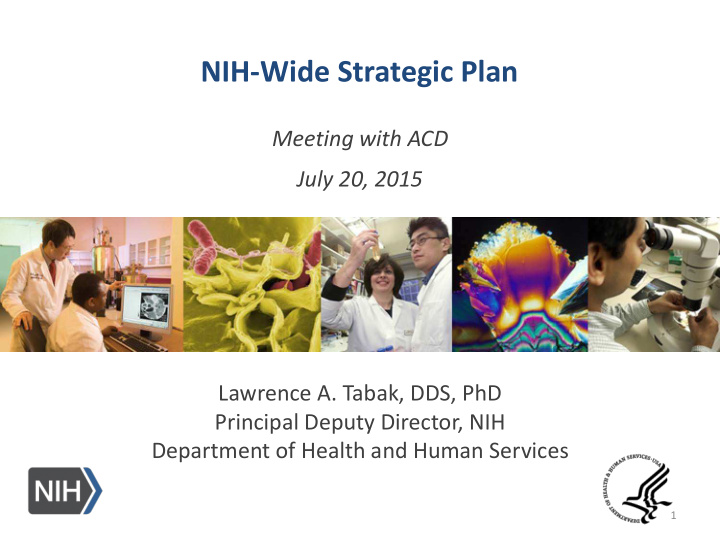



NIH-Wide Strategic Plan Meeting with ACD July 20, 2015 Lawrence A. Tabak, DDS, PhD Principal Deputy Director, NIH Department of Health and Human Services 1
The Original Draft Framework 2
Overarching Goal: Support research in pursuit of fundamental knowledge about the nature and behavior of living systems, and the application of that knowledge to extend healthy life and reduce illness and disability Highest Trans-NIH Priority Areas: Cancer, Infectious and Immunological Diseases, Cardiovascular Disease, Diabetes and Obesity, Brain Diseases and Disorders, Human Development, Chronic Diseases and Conditions Goal 1: Supporting Today's Goal 2: Translating Goal 3: Preparing for the Goal 4: Enhancing Basic Research to Realize Tomorrow's Discoveries into Health Future Stewardship Breakthroughs Objective 3.1 - Recruit and Objective 1.1 - Understand Objective 2.1 - Nurture Objective 4.1 - Optimize Retain a Diverse, Well- Normal Biological Translation of Basic Approaches Used to Trained, and Highly Structure and Function at Discoveries into Novel Inform Institute and Creative Scientific the Level of Molecules Devices and Therapeutics Center Funding Decisions Workforce Objective 2.2 - Advance Objective 3.2 - Strengthen Objective 1.2 - Understand Objective 4.2 - Reduce Individualized Prevention Approaches to Acquire, the Molecular Basis of and Treatment Strategies Administrative Burden on Store, Analyze, and Share Disease and Dysfunction Through Precision Grantees Biomedical Research Data Medicine Objective 1.3 - Develop Objective 2.3 - Develop Objective 3.3 - Create Objective 4.3 - Ensure Technologies for the Next Novel Interventions to Shared and Sustainable Rigor and Reproducibility Generation of Discovery Reduce Health Disparities Infrastructure Cores of Scientific Work Objective 3.4 - Enhance Objective 2.4 - Conduct Objective 1.4 - Develop the Capability to Respond Objective 4.4 - Enhance Rigorous Clinical Trials to New Approaches to to Emerging and Re- NIH Impact Through Test Health Promotion Predict Disease Risk emerging Diseases and Partnerships 3 and Treatment Strategies Other Health Threats
Feedback from ACD Presented to the ACD on June 11 The draft framework did not resonate with the group It was emphasized that we should: Keep the document short (10 pages) – therefore a 4X4 matrix would yield a document that was too long Make it inspirational and forward looking Incorporate cross cutting themes – they felt we relied too much on traditional “organ based” disease paradigms Emphasize flexibility and nimbleness 4
The ACD did appear to resonate with what the strategic plan should and should not be The strategic plan should clearly articulate the highest priorities of the NIH overall The strategic plan should describe how the NIH will achieve the highest priorities The strategic plan should be a living document that will require refinement throughout its lifecycle The strategic plan should not describe all the many important things that NIH does and will do in the future The strategic plan should not address priorities of the individual Institutes and Centers (ICs) since each IC has their own strategic plan (that will each be referenced in the executive summary of the strategic plan) 5
The New Draft Framework 6
7
Draft Framework 8
Draft Framework (cont’d) Areas of Opportunity that Apply Across Biomedicine 9
Draft Framework (cont’d) For each of the Areas of Opportunity: We will have a succinct description of emergent opportunities (and what NIH needs to realize the opportunities) We will also highlight specific examples of recent breakthroughs – “Research Spotlights” 10
Draft Framework (cont’d) Areas of Opportunity that Apply Across Biomedicine 11
Research “Spotlights” Drop-seq single cell analysis* enables large-scale, highly parallel single-cell transcriptomics. Applying this analysis to cells in mouse retinal tissue revealed transcriptionally distinct cell populations along with molecular markers of each type. *Macosko et al., Cell 161:1202- 1214, 2015. http://braininitiative.nih.gov http://commonfund.nih.gov/Singlecell/in 1 dex
Draft Framework (cont’d) Unifying Principles (“Mission Priority Focus Areas”) – which will form the “Objectives” that must be accomplished to achieve Goals 13
Draft Framework (cont’d) For each of the Unifying Principles we will have a description of the current status and/or emergent opportunities (and what NIH needs to realize the opportunities) We will also highlight specific examples of recent breakthroughs – “Stewardship Spotlights” 14
Stewardship “Spotlights” http://commonfund.nih.gov/diversity/index 15
Timeline Activity Timeframe Assemble a subgroup of IC Directors (7-8) to develop the plan, April-15 informed by available DPCPSI framework Discuss draft plan with IC Directors Early June 2015 Present planning process to the ACD, requesting input and their help June 11-12 engaging the public Call with HHS July 10th Call with ACD members July 20th Public comment period (i.e., RFI) July/August 2015 Publish RFI July 20th Webinars Early to Mid-August Analyze and incorporate RFI feedback Mid-August to September Share with National Advisory Councils and gather feedback September-15 Incorporate all feedback October/November 2015 Brief key Hill staff/members Fall 2015 (late Oct/early Nov) Distribute plan to ACD members By November 23 Present at December ACD meeting December 10-11, 2015 Send to Congress Mid-December 2015 16
NIH … Lawrence.Tabak@nih.gov Turning Discovery Into Health
Recommend
More recommend